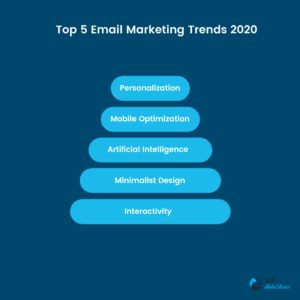We all live in an era where vlogs, tweets and memes are no longer casual exchanges but part of the new marketing lingo. There is also another marketing tool which, regardless of all the changes, have stood the test of time and emerged stronger than ever – emails. The first email in history was sent by Ray Tomlinson, a computer engineer, back in 1971 when no one was aware of its marketing potential. Today, with over 2 billion email users existing worldwide, email marketing has become an efficient digital marketing practice for all businesses. This marketing practice has always allowed businesses to reach their target audience, communicate effectively and increase the brand appeal, all within a short span of time. The strategy’s cost-effectiveness is an added advantage for small, medium and large firms alike. With new marketing trends emerging every year, let’s take a look at some of the hot email marketing trends of 2020

Personalization
While email marketing is not a new concept, the advancement in data and technology is going to take personalization to a whole new level. At present, the businesses segment the mailing list to segregate the subscribers into different groups making it easy to send personalized emails to specific groups. But there is a new trend setting in where brands are exploring various other possibilities for making emailers more personal. Using locations, harnessing data from smart gadgets, sending automated messages that feel personal and reformatting mails depending on where customers read them are all ways by which the marketers will be able to step-up their email marketing campaigns.
Mobile Optimization
Smart-phones are our mini computers which is why it is crucial for firms today to design emailers that are mobile-friendly. A recent study suggested a massive increase in the number of mobile Internet users come 2025, in 2020 alone, the number of smartphone users are estimated to grow to a whopping 7.26 billion. So, with more and more people browsing the internet every day, checking mails and being active on social media via their smartphones, it has become vital for businesses everywhere to consider optimizing their marketing campaigns for mobiles as well. A mobile-friendly emailer works in favour of brand positioning by increasing the click-through rate.
Artificial Intelligence
Over the years the world has witnessed a substantial increase in the amount of data flowing in every second, more than what people especially marketers can handle. And it goes without saying that data is a vital component of marketing, but making sense of it has become quite a challenge. And with the number of data sources increasing every year, the time has come to consider partnering up with Artificial intelligence (AI) to help with the data overload.
Minimalist Design
Since there are a lot of brands existing today, it has become vital for businesses to come up with marketing strategies that would help them stand out from the crowd. This is especially the case for email marketing campaigns since emailers are among the best methods of communicating with the consumers. And the notion that bright images make for eye-catching mails is certainly outdated, instead email templates with simple design and plain texts are considered more authentic and clearer.
Interactivity
Interactivity can be anything that motivates the consumers to click the mail and be influenced in some way. Interactivity can be introduced by attaching games, augmented reality, feedback forms, etc.
The email marketing industry is never on a standstill, it is always evolving all thanks to the fast-paced advancement in data, technology and lifestyle. The email marketing trends used today are more focused on creating a customer-centric, cohesive experience giving brands the leverage necessary to enhance their appeal and gain customer loyalty. So, if you want to capitalize on the current email marketing trends, managing emails is the place to start.




